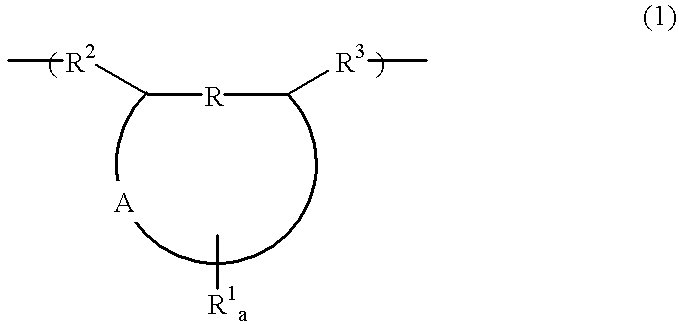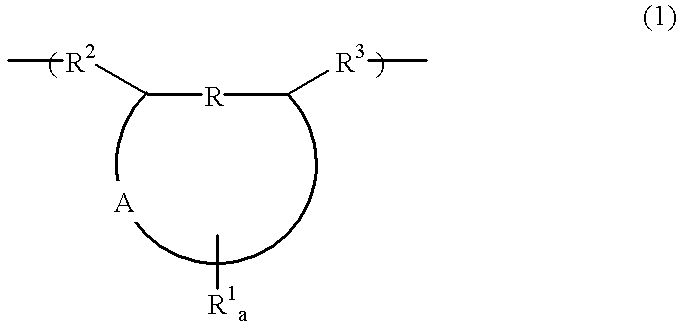Polymer, chemically amplified resist composition and patterning process
a technology of chemical amplification and composition, applied in the field of polymer, chemical amplification resist composition and patterning process, can solve the problems of inability to use resist base resin, difficult to provide transparency, and more difficulty in insuring transparency, so as to improve the negative conversion-preventing effect and high transmittance
- Summary
- Abstract
- Description
- Claims
- Application Information
AI Technical Summary
Benefits of technology
Problems solved by technology
Method used
Image
Examples
synthesis example 1
Synthesis of 2,2,2-trifluoroethyl bicyclo[2.2.1]hept-5-ene-2-carboxylate
A 500-ml three-necked flask was charged with 62.0 g of cyclopentadiene resulting from pyrolysis of dicyclopentadiene. While the flask was placed in a water bath to keep the reaction temperature below 25° C., 125.6 g of 2,2,2-trifluoroethyl acrylate was added dropwise. The water bath was removed at the end of dropwise addition, and stirring was continued overnight. The resulting oily substance was distilled in vacuum, collecting 147.2 g of 2,2,2-trifluoroethyl bicyclo[2.2.1]hept-5-ene-2-carboxylate. The yield was 82.0%.
synthesis example 2
Synthesis of 1-ethylcyclopentyl bicyclo[2.2.1]hept-5-ene-2-carboxylate
In a 1-liter four-necked flask, 75.3 g of 1-ethylcyclopentanol was dissolved in 300 g of methylene chloride. While the flask was placed in an ice bath, 65.7 g of acrylic chloride and a spoonful of dimethylaminopyridine were admitted into the flask. While the reaction temperature was kept below 15° C., 113.4 g of triethylamine was added dropwise. The ice bath was removed at the end of dropwise addition, and stirring was continued for 3 hours, followed by ordinary post-treatment. The resulting oily substance was distilled in vacuum, collecting 86.8 g of 1-ethylcyclopentyl acrylate. The yield was 78.2%.
Using 85.0 g of 1-ethylcyclopentyl acrylate, reaction was carried out as in Synthesis Example 1. There was obtained 89.2 g of 1-ethylcyclopentyl bicyclo[2.2.1]hept-5-ene-2-carboxylate. The yield was 75.3%.
synthesis example 3
Synthesis of Monomer 1
A 1-liter three-necked flask was charged with 22.5 g of sodium hydride, and 350 g of dimethylformamide was admitted thereto. While the flask was placed in an ice bath to keep the reaction temperature below 0° C., 75.7 g of maleimide was added dropwise. The ice bath was removed at the end of dropwise addition, and the reaction solution was ripened for 2 hours. While the flask was placed in a water bath to keep the reaction temperature below 15° C., 123.3 g of tert-butyl chloroacetate was added dropwise. The water bath was removed at the end of dropwise addition, and stirring was continued for 3 hours, followed by ordinary post-treatment. The resulting oily substance was distilled in vacuum, collecting 134.2 g of Monomer 1 shown below. The yield was 81.5%.
PUM
| Property | Measurement | Unit |
|---|---|---|
| Nanoscale particle size | aaaaa | aaaaa |
| Power | aaaaa | aaaaa |
| Power | aaaaa | aaaaa |
Abstract
Description
Claims
Application Information
 Login to View More
Login to View More - R&D
- Intellectual Property
- Life Sciences
- Materials
- Tech Scout
- Unparalleled Data Quality
- Higher Quality Content
- 60% Fewer Hallucinations
Browse by: Latest US Patents, China's latest patents, Technical Efficacy Thesaurus, Application Domain, Technology Topic, Popular Technical Reports.
© 2025 PatSnap. All rights reserved.Legal|Privacy policy|Modern Slavery Act Transparency Statement|Sitemap|About US| Contact US: help@patsnap.com



